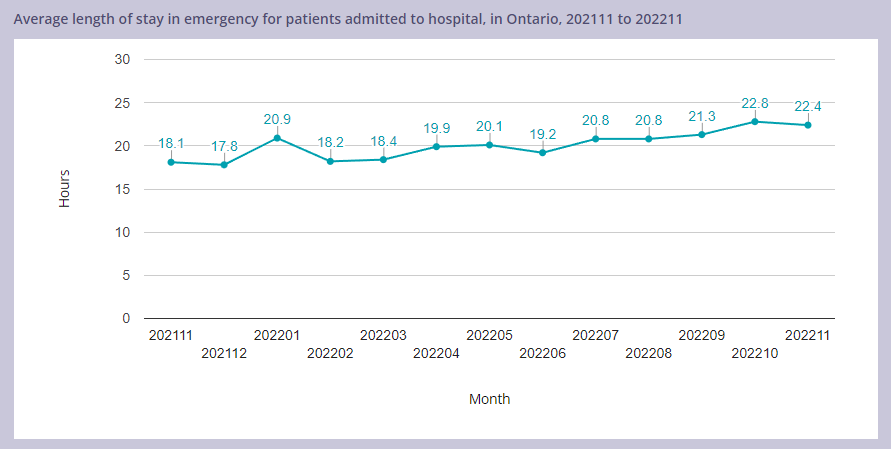Average ER wait times in Ontario drop slightly in November but remain high, data shows
Average wait times for patients being admitted to an Ontario hospital from an emergency room dropped slightly in November after hitting a record high.
According to new Health Quality Ontario data, patients being admitted waited an average of 22.4 hours in an emergency room that month.
This is down from 22.8 hours in October. However, the November wait times are still higher than the 21.3 hour average wait in September, and the 20.8 hour average for July and August.
According to the data, just 23 per cent of patients were admitted to hospital from the ER within the provincial target time of eight hours.
Hospital wait times have steadily been increasing over the last few months, in part due to the triple threat of COVID-19, influenza, and respiratory syncytial virus (RSV).
CTV News Toronto has written numerous stories about patients who waited for hours for emergency care or were delayed due to a lack of available hospital beds. In one instance, a child with pneumonia waited nearly 40 hours in an ER.
Another Ontario man said he waited about 24 hours for treatment of injuries caused by a car crash, while a patient who spent 45 days in a coma and required heart surgery saw his procedure cancelled due to lack of beds.
Wait times are significantly better for those who do not need to be admitted to hospital.
On average, patients waited about two hours on average for a first assessment in the emergency room in November.
About 74 per cent of low-urgency patients who did not need to be admitted, completed their ER visit within the provincial target of four hours. For high-urgency patients, 89 per cent finished their visit within the eight hour provincial target.
 November ER wait time data from Health Quality Ontario.
November ER wait time data from Health Quality Ontario.
Liberal MPP Dr. Adil Shamji said that while the November data represents a statistical decrease, it doesn’t make much difference on the health-care system itself.
“At best this is a rounding error,” he said. “We're just looking at an average, and an average only captures just a very small part of the picture.”
“What I'm certainly hearing from my colleagues, is that we are seeing still massive numbers of patients waiting for inpatient beds in the emergency department every morning. We are still seeing patients who are waiting excessive and unacceptable amounts of time to get into hospital.”
Shamji said the dip could be the result in a slight decrease of RSV and influenza in November rather than an increased hospital capacity.
- Download our app to get local alerts on your device
- Get the latest local updates right to your inbox
The Progressive Conservatives released a plan to stabilize the health-care system in August. Their strategy includes an investment in private clinic surgeries, the addition of up to 6,000 new health-care workers, and legislation that allows hospitals to free beds in acute care by transferring patients waiting for long-term care spots.
“Our government knows emergency department volumes have been increasing year over year and we are not ok with the status quo,” Ministry of Health spokesperson Hannah Jensen said.
“That is why we have taken action by investing in health human resources, freeing up beds across the province and expanding 911 models of care to address wait times as demand rises heading into the fall and winter season to keep Ontario open."
CTVNews.ca Top Stories

Former soldier 'Canadian Dave' taken by the Taliban: sources
David Lavery, a former Canadian Forces soldier who helped approximately 100 people flee Afghanistan during the fall of Kabul, has been 'picked up' by the Taliban this week, according to multiple sources who spoke to CTV National News on the condition of anonymity.
Is Canada Post delivering mail today? What to know about the strike
With Canada Post workers on strike, many individuals and businesses are facing the challenge of sending and receiving mail. Here are the answers to some of Canadians’ most-asked questions.
Canada Revenue Agency eliminating nearly 600 term positions by end of 2024
The Canada Revenue Agency will be eliminating approximately 600 temporary and contract employees across the country by mid-December.
Love story: Nova Scotia couple gets engaged at Taylor Swift's Toronto show
A Nova Scotia couple fulfilled their wildest dreams Thursday night when they got engaged at Taylor Swift’s Eras Tour in Toronto.
Interest in moving to Canada soars amid fears about Donald Trump: immigration lawyer
Fears about the next Donald Trump administration have led to more interest in moving to Canada, including from high-profile individuals, according to an immigration lawyer.
Montreal children's hospitals urging parents to avoid ERs
The two biggest children’s hospitals in Montreal - the CHU Sainte-Justine and Montreal Children's Hospital - are asking parents to avoid bringing their children to the emergency room if possible due to a surge in patients.
Former Waterloo, Ont. school principal pleads guilty to luring, sending sexually explicit material
A former elementary school principal in Waterloo, Ont. has pleaded guilty to charges that include luring and transmitting sexually explicit material to someone believed to be under the age of 16.
'No excuse for this': Winnipeg apartment building without mail for a year
Going to the mailbox to check for letters and packages is a daily ritual for many of us, but not for people living at a Manitoba Housing complex in Winnipeg. They're cut off from their mail.
Tracking respiratory viruses in Canada: RSV, influenza, COVID-19
As the country heads into the worst time of year for respiratory infections, the Canadian respiratory virus surveillance report tracks how prevalent certain viruses are each week and how the trends are changing week to week.

































